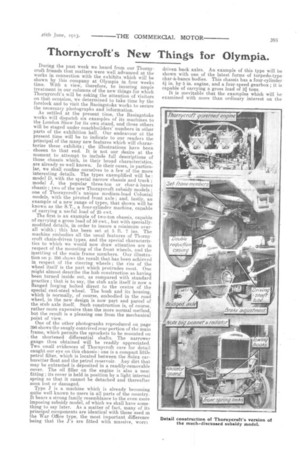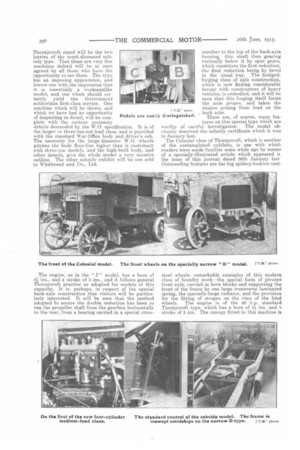Thornycroft' s New Things for Olympia.
Page 21

Page 22

Page 23

If you've noticed an error in this article please click here to report it so we can fix it.
During the past week we heard from our Thornycroft friends that matters were well advanced at the works in connection with the exhibits which will be shown by this company at Olympia in. four weeks time. 'With a view, therefore, to insuring ample treatment in our columns of the new things for which Thornycroft's will be asking the attention of visitors on that occasion, we determined to take time by the forelock and to visit the Basingstoke works to secure the necessary photographs and information. As settled at the present time, the Basingstoke works will dispatch six examples of its machines to the London Show for its own stand, and three others will be staged under coachbuilders' numbers in other parts of the exhibition hall. Our endeavour at the present time will be to indicate to our readers the principal of the many new features which will characterize these exhibits ; the illustrations have been chosen to that end. It is not our desire at the moment to attempt to include full descriptions of those chassis which, in their broad characteristics, are already so well known. In their cases, in particu lar, we shall confine ourselves to a few of the more interesting details. The types exemplified will be : model D, with the special narrow chassis and track ; model J, the popular three-ton or char-i banes chassis ; two of the new Thornycroft subsidy models;
one of Thornycroft's unique medium-load Colonial models, with the pivoted front axle ; and, lastly, an example of a new range of types, that shown will be known as the 8.T., a four-cylinder machine, capable of carrying a useful load of 25 cwt.
The first is an example of two-ton chassis, capable of carrying a gross load of 50 cwt., but with specially
modified details, in order to insure a minimum over all width ; this has been set at 5 ft. 7 ins. The machine embodies all the usual features of Thorny. croft chain-driven types, and the special characteris tics to which we would now draw attention are in respect of the mounting of the front wheels, and the insetting of the main frame members. Our illustra
tion on p. 396 shows the result that has been achieved in respect of the steering wheels ; the rim of the
wheel itself is the part which protrudes most. One might almost describe the hub construction as having been turned inside out, as compared with standard practice ; that is to say, the stub axle itself is now a flanged forging bolted direct to the centre of the special cast-steel wheel. The bush and its housing. which is normally, of course, embodied in the road wheel, in the new design is now part and parcel of the stub axle itself. Such construction is, of course, rather more expensive than the more normal method, but the result is a pleasing one from the mechanical point of view.
One of the other photographs reproduced on page 396 shows the snugly-contrived rear portion of the main
frame which permits the sprockets to be mounted on the shortened differential shafts. The narrower gauge thus obtained will be readily appreciated. Two small evidences of Thornycroft care for detail caught our eye on this chassis : one is a compact little petrol filter, which is located between the iolex car buretter float and the petrol reservoir. Any dirt that may be extracted is deposited in a readily-removable cover. The oil filler on the engine is also a neat fitting ; its cover is held in position by a light internal spring so that it cannot be detached and thereafter soon lost or damaged.
Type J is a machine which is already becoming quite well known to users in all parts of the country. It bears a strong family resemblance to the even more imposing subsidy model, of which we shall have something to say later. As a matter of fact, many of its principal components are identical with those used in the War Office type, the most important difference being that the J's are fitted with massive, worm
driven back axles. An example of this type will be shown with one of the latest forms of torpedo-type char-a-bancs bodies. This chassis has a four-cylinder 4i in. by 5 in. engine, and a four-speed gearbox ; it is capable of carrying a gross load of 31 tons. It is inevitable that the examples which will be examined with more than ordinary interest on the
Thornycroft stand will be the two lorries of the much-discussed subsidy type. That these are very fine machines indeed will be at once agreed by all those who have the opportunity to see them. The type has an imposing appearance, and leaves one with the impression that it is essentially a workmanlike model, and one which should certainly yield the Government authorities first-class service. One machine which will be shown, and which we have had an opportunity of inspecting in detail, will be complete with the various accessory details demanded by the W.O. specification. It is of the larger or three-ton-net-load class, and is provided with the standard War-Office body and driver's cab. The necessity for the large-diameter W.O. wheels pitches the body floor-line higher than is customary with three-ton models, and the high-built body, and other details, give the whole model a very massive outline. The other subsidy exhibit will be one sold to Whitbread and Co., Ltd. Pedals are ens
The engine, as in the " J " model, has a bore of 44 ins., and a stroke of 5 ins., and it follows general Thornycroft practice as adopted for models of this capacity. It is, perhaps, in respect of the special back-axle construction that visitors will be particularly interested. It will be seen that the method adopted to secure the double reduction has been to run the propeller shaft from the gearbox horizontally to the rear, from a bearing carried in a special erosa member to the top of the back-axle housing, this shaft then gearing vertically below it by spur gears, which constitute the first reduction, the final reduction being by bevel in the usual way. The bridgedforging class of axle construction, which is now finding considerable favour with constructors of heavy vehicles, is embodied, and it will be seen that this forging itself forms the axle proper, and takes the
strains arising from load on the back axle. distinguished. There are, of course, many fea tures on this special type which are worthy of careful investigation. The model obviously deserved the subsidy certificate which it won in January last. The Colonial class of Thornycroft, which is another of the contemplated exhibits, is one with which readers were made familiar some while ago by means of a specially-illustrated article which appeared ix. the issue of this journal dated 30th January last Outstanding features are the big spidery-looking cast
steel wheels—remarkable examples of this modern class of foundry work—the special form of dvoted front axle, carried in horn blocks and supporting the front of the frame by one large transverse laminated spring, the specially-large radiator, and the provision for the fitting of stropes on the rims of the hind wheels. The engine is of the 30 h.p. standard Thornycroft type, which has a bore of 4'1 ins. and 14, stroke of 5 ins. The canopy fitted to this machine is sure evidence of the climatic conditions in which this type is generally called upon to operate. Willesden canvas, stretched on a light frame, extends right over the top of the bonnet to beyond the radiator, the front end being supported by suitable iron pillars bolted to the front member of the frame. In this way the driver is protected from heat and from rain, and similar care is taken of the engine under the bonnet This model is a particularly workmanlike-looking job, and although it has been before the interested section of the public for some while, it is certain to attract considerable attention.
The last of the batch of machines which Thornycroft's will stage is a new one, and this is known as the S.T. type. It is to carry a net load of 25 cwt. and it is characterized by a new light design of wormdriven back axle, modelled very much on the lines of that which is fitted, for instance, to the J type which we have already mentioned, and an entirely new design of four-cylinder engine, constructed on the mono
bloc principle. We include illustrations of this interesting new machine, and would, in particular, draw attention, over and above the interesting constrae.
tion of the engine, which is entirely encased, : the employment of a large diameter, leather-disc pattern of universal joint between the dutch and the first shaft in the gearbox ; the proper provision of a small; gear-clriveti cross shaft in the gearbox, with a protruding end for coupling to a milometer, which it is intended to carry outside the main frame ; the fitting of the latest form of Thornycroft exhaust box, consisting of a sheet-metal cylinder with cast ends, held in position by one long bolt ; the embodiment of a. tubular propeller shaft of unusually large diametal. for the power it is required to transmit ; the employment of a neat, die-pressed spectacle plate, which surrounds this propeller shaft and the use of a pressed steel clutch ineruber with the Ferodo lining spring mounted, Other new medium-load four-cylinder models will be a one-tonner and a 45-cwt. machine.
































